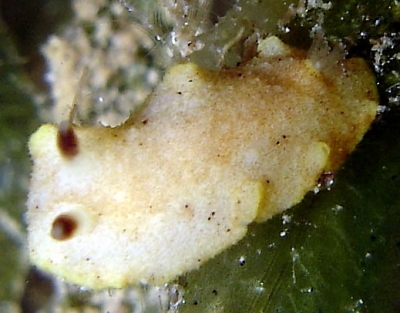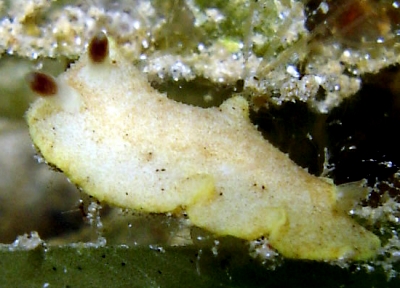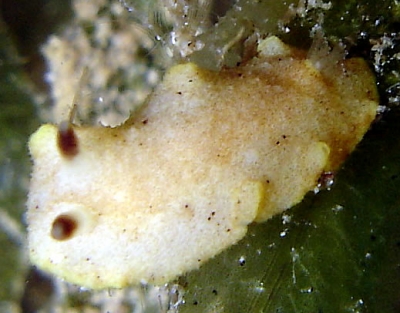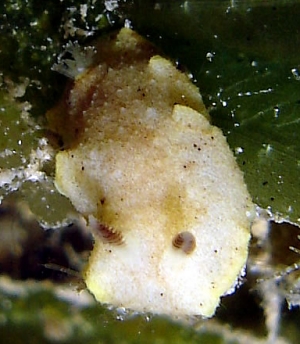
Paradoris erythraeensis
(Vayssiere, 1912)
Order: NUDIBRANCHIA
Suborder: DORIDINA
Superfamily: EUDORIDOIDEA
Family: Discodorididae
DISTRIBUTION
Indo-West Pacific
PHOTO
Locality: Eilat, Satil Area, 24 m, Israel, Red Sea (Gulf of Eilat), 13 May 2006 (night), sea grass, occasional coral heads. Length: 11 mm. Photographer: Binyamin and Shulamit Koretz.
Translucent white, grey or brownish background colour. The mantle has a few light brown patches, each with a centrally placed small black, or dark brown, spot. There are scattered rounded tubercles and the mantle surface contains small whitish spheres. Gohar & Aboul-Ela (1959) reported on their study of large numbers of this species from the Egyptian Red Sea, describing its external shape and colour, foregut anatomy, reproductive system, reproductive behaviour and larval development. Although their study seemed to suggest this was a common animal, few other records of it exist. It is possible that it is often misidentified as a juvenile Discodoris.
In some specimens there appears to be a yellowish band around the mantle edge. It grows to about 5 cm in length alive.
- Dayrat, B. (2006) A taxonomic revision of Paradoris sea slugs (Mollusca, Gastropoda, Nudibranchia, Doridina). Zoological Journal of the Linnean Society, 147 (2): 125-238.
- Gohar, H. A. F. & Aboul-Ela, I. A. (1959) On the biology and development of three nudibranchs (from the Red Sea). Publications of the Marine Biological Station, Al-Ghardaqa, Egypt, 10: 41-62.
- Vayssière, A. (1912) Recherches zoologiques et anatomiques sur les Opisthobranches de la Mer Rouge et du Golfe d'Aden Pt. 2. Annales de la Faculté des Sciences de Marseilles, 20: 5-157,pls1-11.
Rudman, W.B., 2007 (March 1) Paradoris erythraeensis (Vayssiere, 1912). [In] Sea Slug Forum. Australian Museum, Sydney. Available from http://www.seaslugforum.net/find/paraeryt
Related messages
Re: Unknown dorid from Vanuatu
June 5, 2007
From: Bill Rudman
Concerning message #1575:
While trying to identify another 'flat dorid' I came across this animal which I had called "Platydoris sp. 2" for want of a better idea. It looks very similar to a colour photo in Dayrat (2006: Fig. 17 A) identified as Paradoris erythraeensis. Although in the text its colour is described as "dorsal notum ... yellow with a few brown dots and minute dark dots distributed around a few whitish, low, conical, tubercles." the photo shows a white mantle with a yellow border, and a few large blackish spots down each side of the midline. There are also small minute dark spots as described by Dayrat.
Vinka Stenhouse's animal has more large black patches, but otherwise could well be the same species. As Benoit Dayrat comments, we know almost nothing about the colour of living animals of this species, let alone colour variability. Most records of this species are from the Indian Ocean, but Dayrat includes specimens from Thailand, Philippines and Indonesia, so if this specimen is indeed P. erythraeenesis, an animal from Vanuatu is a small extension to the known range of the species.
- Dayrat, B. (2006) A taxonomic revision of Paradoris sea slugs (Mollusca, Gastropoda, Nudibranchia, Doridina). Zoological Journal of the Linnean Society, 147 (2): 125-238.
Bill Rudman
Rudman, W.B., 2007 (Jun 5) Re: Unknown dorid from Vanuatu. [Message in] Sea Slug Forum. Australian Museum, Sydney. Available from http://www.seaslugforum.net/find/19978Paradoris erythraeensis from the Red Sea
March 2, 2007
From: Binyamin Koretz


Dear Bill,
Upon reviewing Benoit Dayrat's revision of the Paradoris genus [message #18271], Nathalie Yonow expressed her opinion to me that this nudibranch, which we had previously assumed to be a Discodoris sp, is Paradoris erythraeensis, formerly Discodoris erythraeensis (Vayssiere, 1912), which I understand has been reported in the Red Sea also by Gohar & Aboul-Ela (1959).
Locality: Eilat, Satil Area, 24 m, Israel, Red Sea (Gulf of Eilat), 13 May 2006 (night), sea grass, occasional coral heads. Length: 11 mm. Photographer: Binyamin and Shulamit Koretz.
There's nothing more I can tell you except we found it just once, last year at night at our most opisthobranch-active site.
Best regards
Binyamin
binyamin@koretz.net
Koretz, B., 2007 (Mar 2) Paradoris erythraeensis from the Red Sea. [Message in] Sea Slug Forum. Australian Museum, Sydney. Available from http://www.seaslugforum.net/find/19466
Dear Binyamin,
Thanks for this record, which I agree is Paradoris erythraeensis. It is a nice addition. Your animal, and one of those illustrated by Dayrat, have a yellowish marginal band on the mantle. Surprisingly Dayrat does not mention it in his review and neither does Gohar, who studied 'a great number of specimens'.
Best wishes,
Bill Rudman
Unknown dorid from Vanuatu
January 28, 2001
From: Vinka Stenhouse

Dear Bill,
Here is one from, Peyrole, Vanuatu, 1997. It was sheltering under a stone during low tide. Approx 3cm long.
Yours sincerely,
Vinka Stenhouse.
Santo.
Vanuatu.
Note added 5 June 2007: This is most probably Paradoris erythraeensis. See message #19978.
Dear Vinka,
In Marshall & Willan's recent book on Great Barrier Reef opisthobranchs this is a species of Platydoris. [Platydoris sp. 1, Fig 144].
Best wishes,
Bill Rudman
